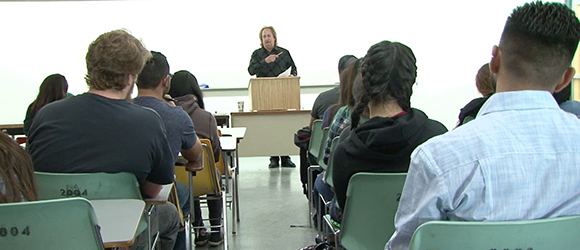
(Photo Credit: John Guenther/CA Fwd)
Originally published at The EvoLLLution.
California faces a confounding juxtaposition (one shared with most other states): thousands of unemployed or underemployed workers living side-by-side with thousands of unfilled jobs.
The great chasm between the two is the skills gap; available workers don’t have the skills that employers need. The gap is wide in California today and isn’t showing signs of narrowing, as projections say that by 2025, 30 percent of all job openings in California (a total of 1.9 million jobs) will require some type of middle-skills training—postsecondary education short of a four-year degree—and the state is expected to fall one million short. We’re not keeping pace, and our residents, companies and economy are at risk.
To address this shortfall in middle-skills workers, the California Community College Board of Governors sponsored the Task Force on Workforce, Job Creation and a Strong Economy, a collection of industry, labor, workforce and economic development, and education representatives. Through extensive input of stakeholders around the state, we uncovered seven broad areas that our college system can address to help close our skills gap.
1. Enable student success
Many community college career technical education (CTE) students need similar and different supports. Work, childcare and other life events are often impediments to program completion. Additionally, many community college students are the first in their family to attend college, so drawing on family experience for assistance is limited. We must enable student success by support of career exploration and planning starting in middle school and high school, collaboration with education and workforce partners to enhance support services once in college, and increased financial support for community college CTE students in ways that recognize their living expenses.
2. Develop career pathways with industry at the forefront
A career pathway is an integrated series of educational programs and experiences designed to put students on a path to a particular career or cluster of careers, and is a proven method for successful employment. It’s imperative to improve career pathways by incorporating employer input at the forefront of their creation, infusing into them workplace-readiness and basic technology skills, and designing them to meet the needs of both traditional and non-traditional students.
3. Continuously improve programs via workforce data and outcomes
To move beyond conjecture, we must look to data and outcomes to anchor our conversations for changing practices. That’s why we need improved initiatives for measuring student progress against common metrics among all workforce programs, increasing the ability of governmental entities to share employment, licensing, certification and wage outcome information, and improving the quality and accessibility of student outcome and labor market data.
4. Streamline the curriculum-approval process
Workers’ skills need to improve at the speed of business, not the speed of lengthy institutional approval processes. Right now, it takes far too long to develop and update CTE curricula through local- and state-level processes, leaving employers without skilled workers and students without current skills. To rectify that, we must clarify and streamline curriculum development and approval processes, achieve better alignment of curricula with the needs of business and industry, and improve articulation across institutions to support portability and completion in our increasingly mobile society.
5. Increase the pool of qualified CTE faculty
Currently, it’s difficult to attract quality CTE faculty because of education requirements and salary differentials. The solutions are to develop pipelines for industry professionals to teach in community colleges, enhance professional development opportunities for current faculty to maintain currency in industry standards, and explore solutions for attracting industry experts to community college teaching from high-salaried fields.
6. Coordinate resources and efforts on a regional level
Resources directed to workforce education come from a variety of sources, and while the goals are similar, the efforts sometimes overlap and cause a fragmentation of services. Additionally, California is comprised of distinct economic regions with unique needs. Therefore, we’re seeking to coordinate all resources on a regional level to meet each region’s needs—for students and employers. This includes coordinating robust regional partnerships among community college, industry, and workforce and economic development entities.
7. Establish a dedicated and sustainable funding source for CTE programs
Currently, CTE courses are funded at the same level as general education courses. Yet, they have higher startup and operating costs. Funding gaps are closed with grants, but those are not long-term solutions. It’s essential to develop a series of funding strategies that include establishing a supplemental funding source targeted to support high-cost courses and programs, creating a funding stream to support regional and local infrastructure and coordination, and leveraging public workforce funding streams to support training efforts for priority sectors in different regions.
To support these seven broad changes, the task force developed a set of 25 recommendations. The California Community Colleges Board of Governors unanimously approved the recommendations in late 2015 and implementation is underway. To learn more about the work and progress of the Task Force on Workforce, Job Creation and a Strong Economy, visit the StrongWorkforce website.
Van Ton-Quinlivan is Vice Chancellor for Workforce and Economic Development at the California Community Colleges and co-lead of the California Economic Summit's Workforce Action Team.

